Moira Butterfield's Blog
March 2, 2025
Where do I Begin? A look at starting points for stories with Mini Grey
“Where do you get your ideas?” is a question you getasked a lot on school visits. I suspect AF Harrold has also often been askedthis question, because in The Book of Not Entirely Useful Advice there is anIdeas Shop, where you can buy reasonably priced ideas.
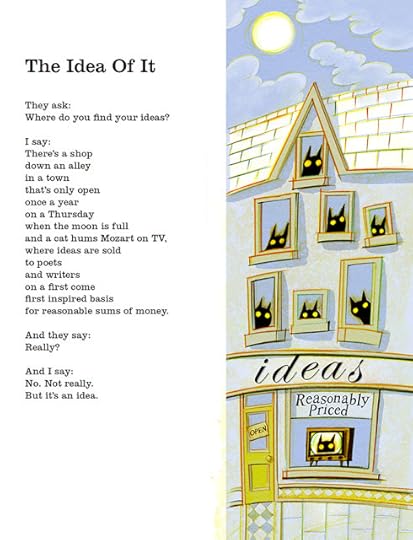
Now the idea of buying a couple of bags of ideas reallyappeals to me. I’ve trawled the backstreets of Oxford and haven’t found theOxford one yet. I'm still looking.
But how do stories get started? When and how did the first whiff of athing that became a book come into being? So my mission in this post is to be a Starting Point Detective, and track down those elusive beginnings.
JK Rowling, when describingher creative process, talks about a Lake and a Shed. There’s a Thing in theLake that hands you stuff that you take to your shed and work on, hammeringaway at it.
“I feel as though the inspiration is thething that lives in the lake that’s very mysterious, that I never see. But it handsme stuff. And then I have to take this unformed stuff – sometimes it can bereasonably formed, sometimes it’s very blobby like molten glass or something,and then I have to take it into the shed and there I have to work on it.”

JK Rowling is working withideas and words, but when you’re a picture-book-maker, you’ve got all thevisual ideas to play with too. My sketchbook is my shed and my collecting place:in the back pages are my shelves and drawers for any scrappy ideas to be stored.In the middle pages is the workshop: when the time is right, a poor blinkingsquinting idea can be brought from the back out into the middle zone and I seeif there’s anything it can become.
 Sketchbook back pages in which I scribble down my brilliant idea for some Pirate Nuns... Some treasures from the back of sketchbooks can bething you found or cut out of newspapers.
Sketchbook back pages in which I scribble down my brilliant idea for some Pirate Nuns... Some treasures from the back of sketchbooks can bething you found or cut out of newspapers. A news story about a mysterious smell. Could I do something with this forgotten lunch?
A news story about a mysterious smell. Could I do something with this forgotten lunch?
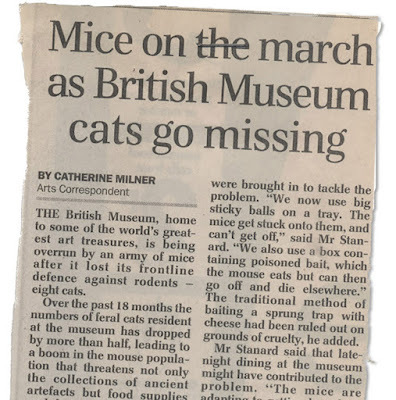 Starting place? Mice vs cats at the British Museum
Starting place? Mice vs cats at the British Museum Ideas have a habit of evaporating and being lost. The trick is to make sure the ideas don’t fly away – to be a butterfly collector and pin them down, and keep them safely captive until you can bring them into the workshop.

Sometimes catching a starting point means being aStory-Sniffer: following a trail to a story: a scent, a place, a mood. Thismight mean starting with making pictures, with a colour palette, a fox in amoonlight night, someone running through green forest.

But sometimes starting might be a train of thought, a voice-over. Here's a sketchbook page:

I was on a train, I had this idea about magic show bunnies that I was stuck with. Then I started just performing the show, beingthe Announcer, and that gave me just about all the story of the Bad Bunnies'Magic Show.
Asking WHAT IF? (or WHAT COULD?) can be a good starting place. The Adventures of the Dish and the Spoon started with thinking about all the things that a Dish and a Spoon could do together:

...and in those things were the seeds of a love storyand the danger of being broken.
Here's the first idea for The Last Wolf on an always-useful post-it note:
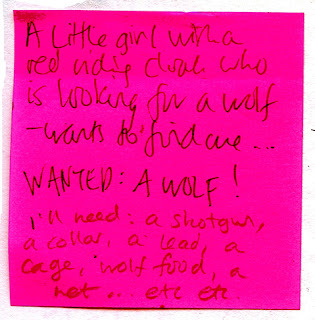
Sometimes why not just steal a story? Sometimes you've started with a stolen story without realising it. My book Hermelin, I realised after I'd made it, was really an attempt to remake a favourite childhood book about a cheese-loving proud mouse with a typewriter: Anatole, by Eve Titus and Paul Galdone.
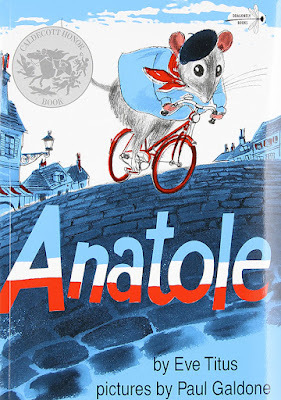
Starting with a badlyremembered story can lead you to new and wonderful places. Jon Klassen's book The Skull began with a folktale in a library in Alaska that Jon read while waiting to do a presentation. He put the book back on the shelf, but afterwards thought about the story, remembered the story, reimagined the story. Eventually he'd remade the story. He contacted the Alaskan Library and tracked down the original tale, and it was wildly and disappointingly different to the story of Otilla and the Skull that he'd made. So a badly remembered thing can lead to a good thing.
A Start can be with an escapedstory; and an ending can become a beginning. The Bad Bunnies that I was pondering about earlier on the train, had actually escaped from a book of poems I'd illustrated by June Crebbin, specifically this poem about a magic show crime scene:

Starting can be with a thing thathappened. Sometimes it's a lost thing: here are a couple of lost things that inspired stories:
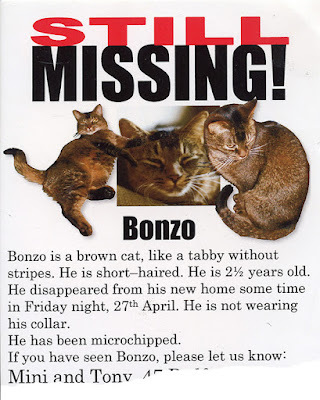 Our missing Cat Bonzo for a starting point for Hermelin.
Our missing Cat Bonzo for a starting point for Hermelin.
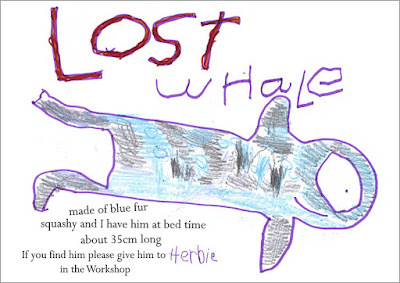 You wouldn't think it was possible to lose a whale...
You wouldn't think it was possible to lose a whale...So you have a starting point to think about - now you need ingredients for your story, you need to collect things that might happen. One way to collect ideas is to draw. Draw to explore: to go ideas-fishing. Drawing pulls out more ideas like pulling out fish from a dark bottomless lake. Ideas happen while you are drawing, the act of drawing makes ideas happen. I always use the scrappiest paper possible no nothing matters, this does not have to be a good drawing.
I thought I’d try and map out all the things I’m interestedin and like drawing and like thinking about, so if I ever need a starting pointI can pick one from my Starting Points Mind Map, and take it to the workshop and see what happens.So here it is:
 My Starting PointsDirectory Mind Map
My Starting PointsDirectory Mind MapIt's on my wall for whenever I might need a startingpoint. Maybe I could randomly choose two things off it and see what happenswhen I put them together - I actually put a Combination Machine in the bottomright corner for just this purpose...
So now it's definitely time to end this post about starting points. I wish you much happy ideas-fishing in your own personal lake - or whatever or wherever your ideas come from.
January 20, 2025
25 PICTURE BOOKS TO LOOK FORWARD TO IN 2025
At this time of year there are a few 'looking forward to' book lists doing the rounds. But here are some very exciting picture book-shaped offerings that caught my eye!
JANUARY
1. THE REALLY BEAUTIFUL THING (Frances Tosdevin, Ali Pye)
Squirrel is prepared to sell everything he has for The Really Beautiful Thing, but at what cost? A cautionary tale with a heartwarming ending about the force of greed and the power of friendship and family. The perfect story to share with little ones about consumerism, greed and obsession, that teaches us we can't always have everything we want . . . and that our loved ones will always be there to help us when we lose our way.
Squirrel doesn’t know what The Really Beautiful Thing is, or even what it does, but it’s AMAZING, and he wants it…even if it costs him EVERYTHING.
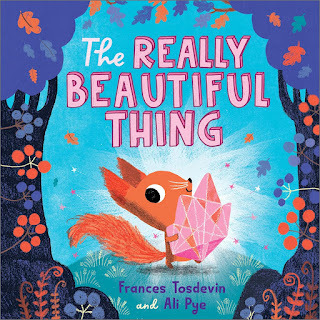
2. THE GREAT UNICORN RESCUE: A magical adventure about facing your fears (Diane Ewen)
The Great Unicorn Rescue is an enchanting, unicorn-filled tale about friendship and fighting your fears, from the award-winning, bestselling Diane Ewen.
Louella lives on the edge of a forest. But this isn't just any forest – this forest has unicorns in it! Louella's unicorn is called Norrie, and they love collecting shells together from the stream and spending all day together. Norrie’s special power is being able to cast a bright beam of light – so although Louella’s biggest fear is the dark, she never has to worry with Norrie around!
Until, one day, when Louella’s school has a class trip into the forest and Norrie doesn’t appear. Where could Norrie have got to? Can Louella overcome her biggest fear to help her friend out?
An enchanting story about friendship and how facing your fear with friends might just make that fear disappear altogether!
The authorial debut from Diane Ewen, illustrator of Coming to England and winner of the Jericho Prize and the Queen’s Knickers award.
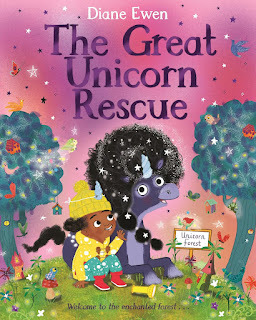
FEBRUARY
3. THE FULL STOP THAT GOT AWAY (Laura Baker, Nathan Reed)
Frank is a full stop who LOVES making up stories. But sometimes the stories won’t stop, even when Frank says, “The End.” And when a dragon takes over, Frank has had enough… But without a full stop, how will the story ever finish?
A hilariously non-stop story about learning to let your imagination flow, and the perfect first introduction to punctuation.
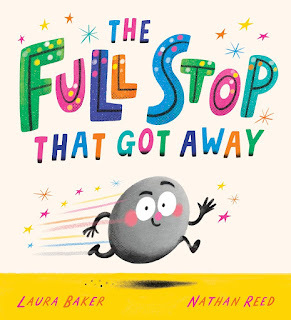
4. OH NO, FLO! (Catherine Cawthorne, Mike Byrne)
Farmer loves looking after her animals. Farmer does all the jobs that need to be done. And she does them just right. But most of all, Farmer LOVES her trusty sheepdog, Flo. So when Farmer gets sick, Flo leaps in to SAVE THE DAY! The only question is, what does Farmer actually DO all day? With the help of her farmyard friends, Flo sets to work: brushing the carrots, collecting the geese, sowing the sheep. . . HOLD ON! OH NO - Flo is in a muddle!
Will Flo be able to get all the jobs done in time? Or will this farmyard fiasco go from bad to worse?
This laugh-out-loud animal adventure will have all readers shouting 'OH NO, FLO!' as Flo's antics unfold, making it the perfect book for storytime. Ideal for fans of Duck in the Truck, You Can't Take an Elephant on the Bus and Poo in the Zoo.
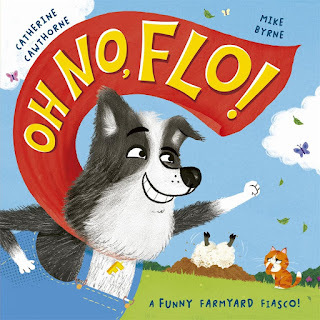
5. DO NOT EAT THE EGG (Fiona Barker, Siân Roberts)
The perfect picture-book treat for every small child (and adult) who has tried to resist temptation... and failed!
When Small Rabbit discovers a gorgeously wrapped chocolate egg in the cupboard he can't WAIT to eat it. But the label says Do NOT eat the egg! Can Small Rabbit do the right thing... or will it turn into a gloriously gooey chocolate disaster?
Chocolatey perfection for fans of Chris Haughton and Jon Klassen
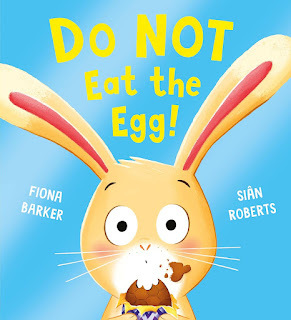
6. THE SPACE BETWEEN (Clare Helen Welsh, Fiona Lumbers)
Granny has a secret: big changes aren't so scary when we take comfort in the time it takes to embrace them.
When her granddaughter is missing her old home, Granny teaches her a secret. The flower buds aren’t quite open, but they will be soon: they’re in the space between, and that time is a gift to treasure. Just like the flowers will soon bloom, in time she will feel at home. But Granny’s in the space between too... and she might need a little help to come out on the other side.
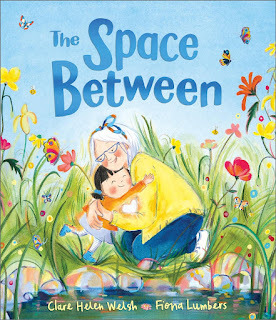
MARCH
7. HENRY THE ARTISTIC DOG (Justin Worsley)
Henry doesn't think anyone appreciates his unusual art, but one night everything changes...
Henry is an artist, a master sculptor and . . . a dog. Unfortunately, his self-made pieces, in all their sculptural forms, are often tossed in the bin without even being noticed! But Henry never gives up on his art until, one day, an unexpected somebody finally falls in love with his work and at last Henry has his moment to shine.
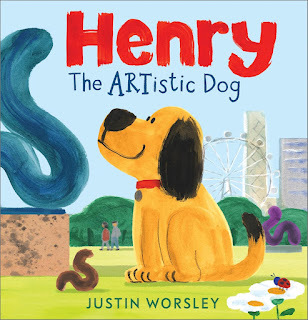
8. I’M GONNA EAT A MONSTER! (Kael Tudor, Scott Wilson)
Join Little Rabbit and Grey Wolf on their quest to EAT a monster in this hilarious new picture book story.
One morning, deep in the forest, Grey Wolf spots a delicious-looking rabbit and thinks to himself: Time for breakfast! But Little Rabbit isn't scared. In fact, she has plans of her own – plans to find and EAT a monster.Which is ridiculous, of course, because monsters AREN'T REAL.
Or are they?
Written by picture-book rising star Kael Tudor and brought to life by debut illustrator Scott Wilson, this read-aloud adventure is full of clever humour and LOTS of unexpected twists and turns.
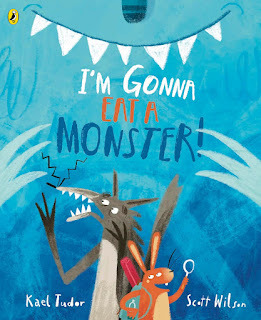
9. THE FLOWER THIEF (A Squirrel & Bird Book) (Alice Hemming, Nicola Slater)
Perfect for fans of Fletcher and the Springtime Blossoms, the spring-themed companion to the New York Times bestseller The Leaf Thief!
"Hello brand new day.
Hello sunshine!
Hello lovely leaves.
Nice to see you back."
Spring is here and today a flower has sprung to life. But when Squirrel becomes too protective of it, Bird shows Squirrel the right way to let flowers blossom and grow.
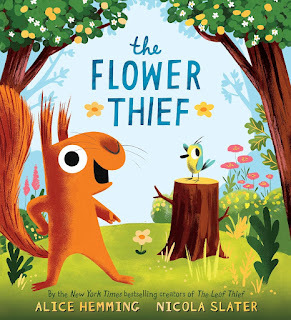
10. BADGER BOOKS (Paddy Donnelly)
From the world of Fox & Son Tailers…
‘Badger Books’ is a bookshop, run by a badger. On its shelves, you can find books about every animal. From bears to elephants, tigers to dinosaurs and pandas to narwhals. But there’s one book they don’t have … and it’s one that Rory the Fox really, really wants.
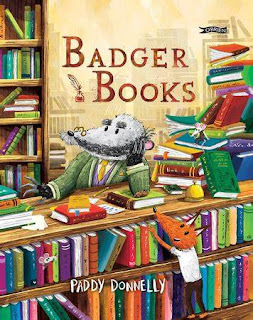
11. BY THE BEAVER POOL (Catherine Ward, Phoebe Roze)
Each day, as the sun peeked out from behind the clouds, I unpacked more of my favourite things.
Each evening, as the sky grew sleepy, we went to watch the beavers. The dam grew and grew…
Beck learns to love living at Grandma’s farm with the help of a pair of beavers that have moved to the stream nearby.
As Beck settles in at Grandma’s farm in Scotland, they watch the beavers busily gathering sticks to build a dam, which creates a pool and wetland habitat where lots of other wildlife can live too. As the seasons pass, Beck and the beavers find happiness in their new homes. By the Beaver Pool is a gentle tale of rewilding, connecting with nature and feeling at home, which cleverly weaves in facts about these incredible creatures.
A moving story of new beginnings that will also teach children about the brilliance of beavers.
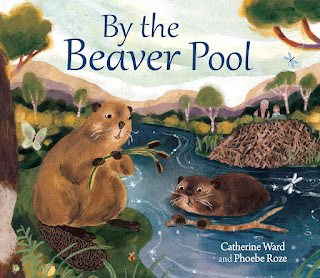
APRIL
12. BASIL DREAMS BIG ( Lu Fraser, Sarah Warburton)
An adorable story about self-belief from the creators of Mavis the Bravest and One Camel Called Doug.
“How do I steer? And how do I stop?
What if I lose all my UPNESS and … drop?!”
Basil the bat doesn’t believe he can fly. No matter how hard he tries, he just can’t do it. But when a thundering storm threatens the safety of his beloved friend, Moth, will Basil find his wings and believe in the bat he CAN be?
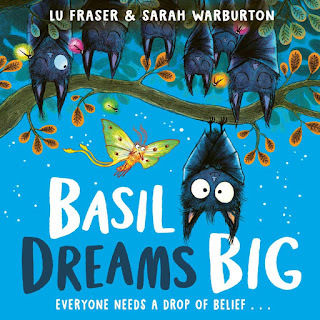
13. THESE ARE MY ROCKS: A Story About Collecting (Bethan Woollvin)
Join the narrator, as they proudly introduce the reader to their prized collection, featuring BIG things to small things … and spiky things to wobbly things!
Each page is bursting with humour – and they are interactive too – with children encouraged to interact with the book, with invitations to point, make noises, clap their hands and think about what they could collect..
Interactive books engage young children and capture their natural curiosity and These Are My Rocks encourages the development of important early-learning skills such as listening, choosing, matching, counting and moving by playing on the theme of interaction.
These Are My Rocks is stylish, humorous, inclusive and utterly engaging – and a celebration of children's love of collecting.
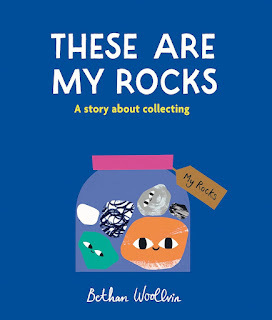
14. HOW NOT TO SHARE A PIZZA (Tracy Curran, Lauren Beard)
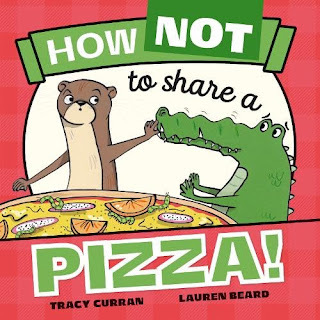
MAY
15. ALL THE WONDERFUL WAYS TO MOVE (Laura Baker, Sandra de la Prada)
Jump up off your bottom and get in the groove.
Wiggle your body, let’s see how you MOVE!
Stomp, hop and clap along to the bouncy rhyme in this playful celebration of moving your body. A follow-up to All the Wonderful Ways to Read.
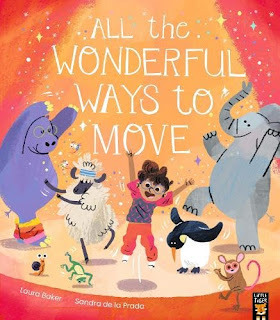
JUNE
16. THE ROCK FAMILY BAND (Robert Tregoning, Laura Brenlla)
Meet The Rocks! The family’s youngest member, flute-playing Sam, is different from the rest of his glam-rock family and sometimes they clash. Can the Rocks find a way to bring harmony into their music and into their home? Find out in this picture book about embracing each other for being who we are, whatever the tune that we sing and no matter how glam-rock we roll!
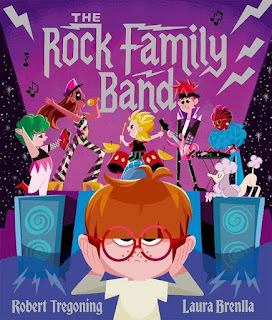
17. LLAMA LIBRARY (Holly Ryan, Ella Bailey)
This isn’t a library for book-borrowers – in this library you borrow a llama!
The Llama Library has any subject you can imagine – cookery, history, art, music, science even romance! All you need to do is go to the section and choose your llama, give the librarian your card to stamp and you can take it home. And that’s where things might get a little… messy! But don’t worry – just return your llama to the library and borrow another.
Holly Ryan’s hilarious story of a library from another dimension is bright to life by the incredible Ella Bailey. The magic of borrowing from your local library has never been this funny!
18. PUT YOUR SHOES ON (Polly Dunbar)
Every morning, all across the globe, children are being asked to put their shoes on. And, every morning, across the globe... no children are putting shoes on their feet, including Josh.
Mummy is desperate for Josh to put his shoes on – they have Aunty Nelly's party to go to! His cousins Tobias and Clementine will be there! (With their best shoes on.) While she asks nicely, cajoles, and eventually shouts (a bit), what she can't see is that Josh is actually VERY BUSY: he is completely lost in his own imaginative landscape inhabited by wild and wonderful creatures, made from real children's drawings by Polly Dunbar's son.
In his own head, Josh is indeed putting shoes on ... just not on his own feet. Cleverly fusing together two unique art styles, Polly connects us to the inner life of a child and all the little worries and distractions they wrestle with as soon as they know they have to leave home. In the end, she asks for a little more patience and love ... for both parent and child.

JULY
19. IS THAT YOUR MAMA (Patrice Lawrence, Diane Ewen)
A beautiful, moving celebration of what it truly means to be family, from the brilliant new picture book duo Patrice Lawrence and Diane Ewen.
Every family is different. Every family is special.
Josie loves her family. Her mum, dad, brothers and sister - they're all the best and they all look different.
But people always seem to ask Josie "Is that YOUR mama?", and soon she starts to wonder if her family are actually supposed to look the same.
When Josie shares her worries with her family, they find a way to help her see what truly matters.
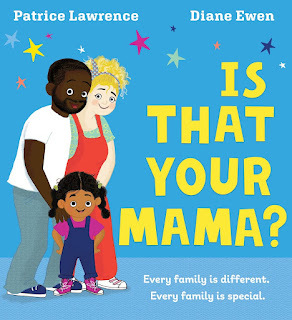
20. THE DANGEROUS PET LOVER’S GUIDE TO DRAGONS (Lindsay Hirst, Alice McKinley)
Dragons are well known for being sulky and difficult. However, by following these simple but important guidelines, you might just be able to create a loveable and (almost) friendly pets.
The Dangerous Pet Lover’s Guide to Dragons is the essential dragon-care manual you didn’t know you needed. Full of useful tips, tricks and advice on everything from feeding and housing your new dragon to grooming and washing it (top tip: DON’T EVEN TRY!), this handy guidebook will equip you with everything you need to bond with your new pet!
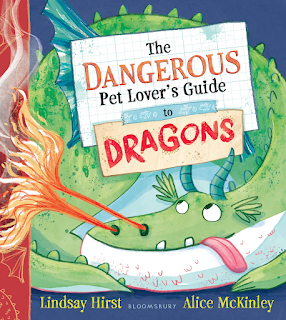
21. A MILLION CHAMELEONS (Rachel Morrisroe, Aysha Awwad)
A laugh-out-loud chameleon word-play explosion - perfect for reading aloud together!
The world is home to millions of colourful chameleons. What do you think they get up when no one is watching?
From cheeky flicking-pea-leons to cute-as-cute-can-be-leons and even always-needs-a-wee-leons, there's SO much more to these creatures than meets the eye!
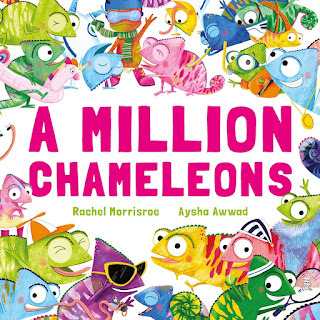
AUGUST
22. THE BIG MONSTER BAKE (Fiona Barker, Eve O'Brien)
Come on down to MonsterStreet this howlingHallowe’en.
The houses look spooktacular, a truly splendid scene.
We’ve been busy cooking and we’ve made a monster bake.
I wonder, would our neighbours like a slice of tasty cake?
The Big Monster Bake is a picture book with a sweet and inclusive approach to Halloween. It stars a pair of little monsters hoping to share a homemade cake with their neighbours on Monster Street.
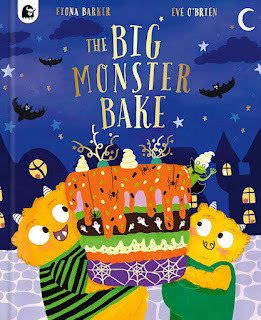
23. THE GREAT NUT HUNT (Karl Newson, Nia Havilliard)
Up and down, high and low.
Over and under and into I go . . .
When I’m hunting for nuts!
Squirrel LOVES nuts. He loves them so much that he collects AS MANY AS HE CAN! There’s just one problem: with so many nuts hidden around the woods, Squirrel just can’t remember where they all are. Oh, nuts!
Full of energy and fun, this gorgeous picture book brings together Karl Newson and Nia Tudor for the very first time!
With a bouncy rhyming text and illustrations full of colour and detail, The Great Nut Hunt is perfect for autumn - and all year round!

SEPTEMBER
24. I DEFINITELY DON’T LIKE THE DARK (Fiona Barker, Christine Pym)
A heartwarming picture book about two best friends who learn how accept each other's differences.
Hank and Hoog are best friends - they do EVERYTHING together.
Until one evening when Hank confesses that he's scared of the dark... Hoog can't understand - there's nothing to be scared of! But Hank can't stop thinking about the shadows, and what's making those night time noises? They may not agree on the dark, but there's something they both definitely like: each other.
And with a good friend, there will always be light in the darkness...
(Enjoy more of Hank and Hoog's adventures with the first book in the series I Definitely Don't Like Winter)
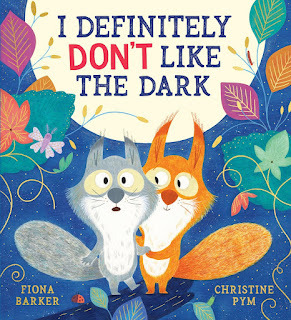
OCTOBER
25. I’M GOING TO EAT A POLAR BEAR (Karl Newson, Nicola Kinnear)
A little penguin is hungry but bored of eating fish and decides it wants to eat something different! An older penguin recalls hearing of a fluffy creature called a polar bear, so the little penguin sets off to find one. On arrival at the North Pole, the penguin can’t see a polar bear anywhere and eventually turns back home. Unbeknownst to hungry penguin, though, an equally hungry polar bear is following right behind...
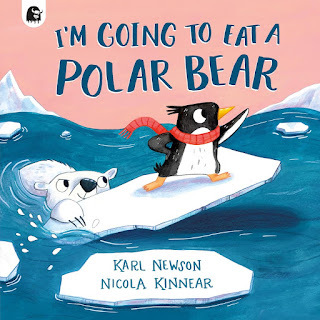
What a lot of lovely stories to look forward to!
Which ones did we miss?
Feel free to tell us what other picture books there are up and coming in the comments.
Happy reading!
December 15, 2024
A Christmas story for you, by Pippa Goodhart
After thirteen years of being a regular contributor to this lovely Picture Book Den, I've decided that this will be my last regular post here. What should my last post be? It's landing at Christmas, so I give you a gift of a story about giving. It's a story intended for a picture book, but which has yet to find a publisher who wants it. I hope you enjoy it -
What Can I Give?
One morning my phone goes - Bleep-bleepety-bleep!
It’s Mole.
‘Hello, Moley, how are you?’
Mole just sighs and says nothing.
‘Shall I come and see you?’ I ask.
‘Yes please, Rabbit,’ says Mole.
‘I’ll bring you a present to cheer you up,’ I tell her.
But I haven’t got a present. What can I give her?
I think of Mole in her gloomy dark hole.
I want to give Mole colours!
So I stitch-stitch a quilt to wrap-hug Mole up in sky blue, leaf green, berry red.
‘I think she’ll like this!’
But, as I set off to Mole’s hole home, I see Badger, and Badger is shivery-quivery cold.
What shall I do?
What would you do?
I give the quilt to poor cold Badger.
‘Thank you, kind Rabbit,’ says Badger.
I’m glad that Badger’s warm, but now what can I give sad Mole?
Perhaps I can give her some fun.
So, I make a toy for Mole.
I make a fine little boat to float in Mole’s bath; a boat for her to play with.
I know that she’s waiting for me, so I must hurry to take it to her.
But, as I scurry along the path, I see Mouse. Poor little Mouse is gulp-sniff-sobbing.
‘Oh dear, Mouse, what’s the matter?’
‘I got left behind,’ sniffs Mouse. ‘And now I can’t catch up with my friends, and it’s getting late, and I don’t know what to do-oo-oo! Boo hoo!’
‘Oh.’ I look at the little boat I’d made for Mole.
What shall I do? What would you do?
‘Would a boat that could float you down the river help?’ I ask.
‘Oh, yes please, kind Rabbit!’ says Mouse.
So, Mouse floats away in the boat to catch up with his friends.
But now what can I give Mole?
I haven’t got time to go home and make anything new. All I can do is to collect pretty things as I go along the path. So, I make a bouquet of twigs and leaves and berries to bring beauty into Moley’s home.
But just as I am about to knock on Mole’s door, I see Hare, bounding along the path.
She sees my bouquet, and she says, ‘Oh, my goodness gracious me, is that big bouquet all for me? How did you know it was my birthday today? Hooray! Thank you so much, kind Rabbit!’
So, of course, I give Hare the bouquet.
And now I have nothing to give to my friend Mole, nothing at all. But I’d promised to give her a present! Shall I just creep away, and come back again another day?
What would you do?
Uh-oh, oh no, Mole has seen me!
‘Come in!’ calls Mole.
So that’s what I do.
I tell Mole about trying to bring her colours, making a quilt, and meeting a shivery Badger. I tell about trying to bring her fun, with the boat that was needed by lost little Mouse. I tell about the bouquet that made Hare birthday-happy.
‘So, I’m sorry, dear Mole, but I have nothing to give you after all. Nothing. Nothing, at all.’
‘That’s not true!’ laughs Mole. ‘You have brought me a story full of lovely things. I love stories.’
That gives me an idea. ‘Shall we make the story into a book?’
So, together, Moley and I make the story into a book.
‘The perfect present!’ smiles Mole. ‘Thank you, kind Rabbit.’
And her smile is the perfect present for me.
My hope was that this, as a book, could look as if its hand-written, and could perhaps include what look like scrapbook additions of scraps of quilt fabric and winter flowers etc, thus appearing to be the book they make at the end of the story.
Pippa Goodhart
Wishing you all a very happy Christmas!
PS My You Choose Christmas, beautifully illustrated by Nick Sharratt, is newly out in paperback:
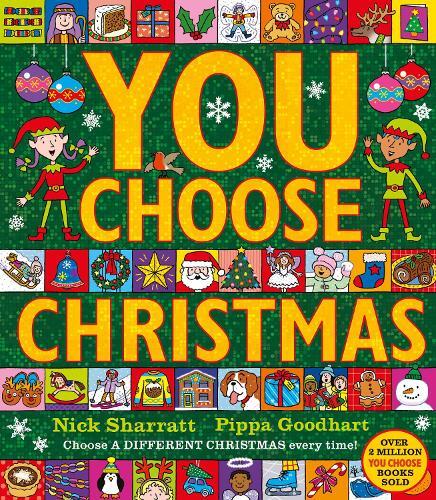 A
A
December 1, 2024
How to Imagine a Picture Book World • By Natascha Biebow
The World's A Wonderful Place If You Can Only Visualize It!
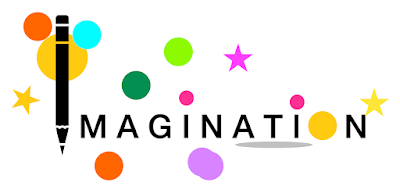
When children are young, their actual world is relativelysmall and they are just beginning to grasp what the wider world looks like. Day-to-dayrevolves around home, routines, family, the neighbourhood, nursery andpreschool, and everyday tasks and celebrations. Yet young children have vivid imaginationswith almost unlimited scope. From just under a year, their pretend play takesoff and they soon start to play with props and people around them as if theywere real.
Enriched pretend play helps young children develop empathyand social skills, learn new concepts, gain confidence and independence, understandhow the world works, and improve motor skills.
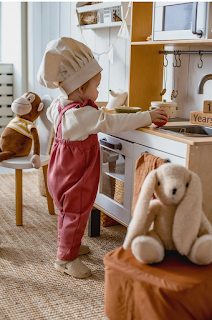
When children see the possiblities in books, this can bothvalidate their imaginative play and serve as a springboard for new ideas.
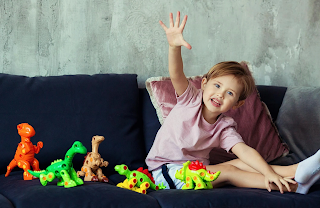
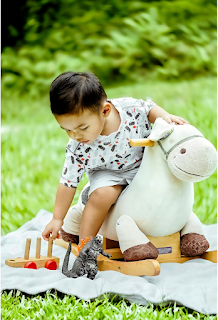
In picture books, writers and illustrators can do just aboutanything as long as the internal logic is sound.
Pairing seemingly random characters and objects together create such interesting, fun and compelling worlds.
A bucket portal into an ocean world? Yes!
 From Billy's Bucket by Kes Gray and Garry Parsons
From Billy's Bucket by Kes Gray and Garry ParsonsOr even a bucket that is full of dinosaurs – didn’tyou know?
 From Harry and the Bucketful of Dinosaurs Go to School by Ian Whybrow and Adrian Reynolds
From Harry and the Bucketful of Dinosaurs Go to School by Ian Whybrow and Adrian Reynolds
Dragons that wear underpants. Of course!
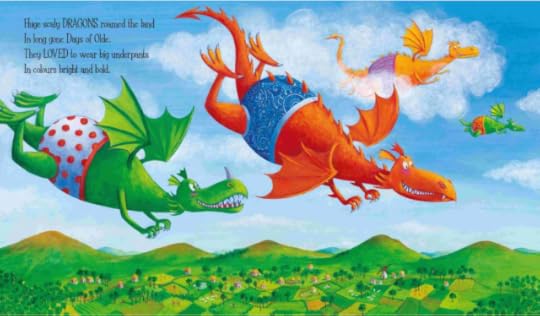 From Dragons Love Underpants by Claire Friendman and Ben Cort
From Dragons Love Underpants by Claire Friendman and Ben CortA Tiger who drinks all the water in the tap – certainly.
 From The Tiger Who Came to Tea by Judith Kerr
From The Tiger Who Came to Tea by Judith KerrA dragon who scarfs tacos?
 From Dragons Love Tacos by Adam Rubin
From Dragons Love Tacos by Adam RubinA generous witch with room for everyone on her broom . . .
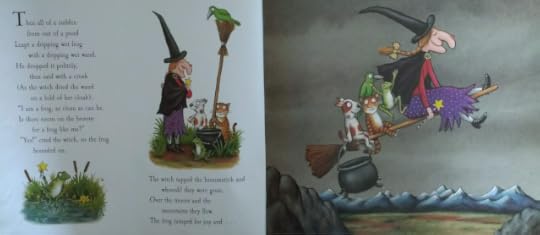 From Room on the Broom by Julia Donaldson and Axel Sheffler
From Room on the Broom by Julia Donaldson and Axel ShefflerA boy who can sail alone to the land of the monsters and be King . . .
 From Where the Wild Things Are by Maurice Sendak
From Where the Wild Things Are by Maurice Sendak
A seed who is bad (but doesn't mean to be)?
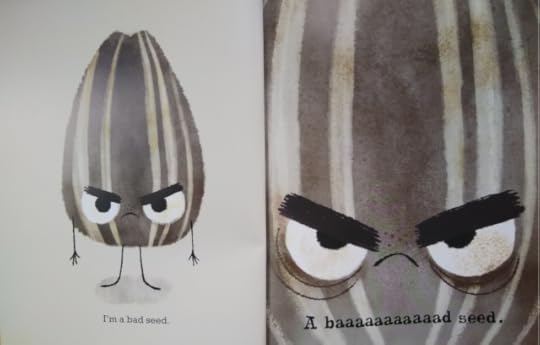 From The Bad Seed by Jory John and Pete Oswold
From The Bad Seed by Jory John and Pete OswoldCows that type and Ducks that negotiate. . .
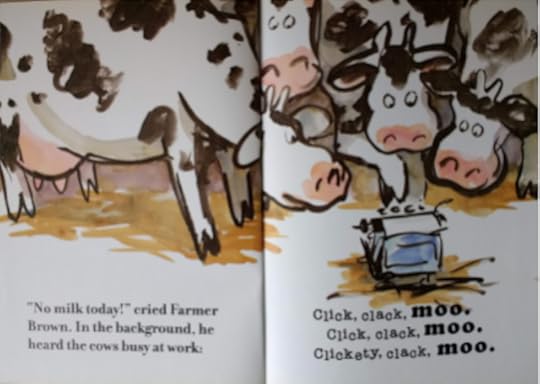 From Click, Clack, Moo, Cows That Type by Doreen Cronin and Betsy Lewin
From Click, Clack, Moo, Cows That Type by Doreen Cronin and Betsy Lewin
Crayons that rebel . . .
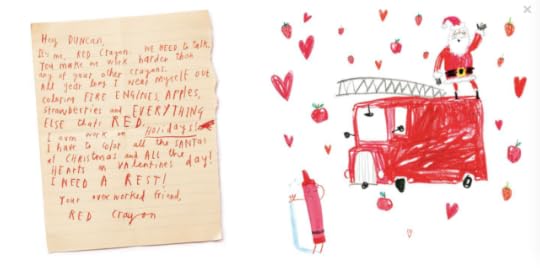 From The Day the Crayons Quit by Drew Daywalt
From The Day the Crayons Quit by Drew DaywaltA pigeon who wants to drive a bus . . .?
 From Don't Let the Pigeon Drive the Bus! by Mo Willems
From Don't Let the Pigeon Drive the Bus! by Mo Willems
A snowdog that can fly!
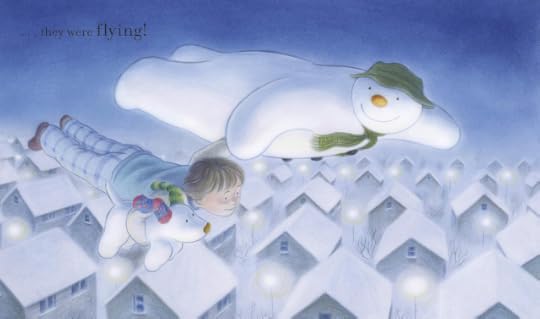 From the Snowman and the Snowdog based on the characters created by Raymond Briggs
From the Snowman and the Snowdog based on the characters created by Raymond Briggs
EVERYTHING is possible!
Imaginative play is empowering and fun. And it’s a greatexcuse to just PLAY.
What book world will you create? Where will you go and who will be there?
_________________________________________________________________
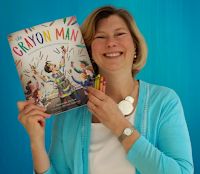 Natascha Biebow, MBE, Author, Editor and Mentor Want to level up your picture books? I am launching a new online picture book course!
Natascha Biebow, MBE, Author, Editor and Mentor Want to level up your picture books? I am launching a new online picture book course!
Natascha is the author of the award-winning The Crayon Man: The True Story of the Invention of Crayola Crayons, illustrated by Steven Salerno, winner of the Irma Black Award for Excellence in Children's Books, and selected as a best STEM Book 2020. Editor of numerous prize-winning books, she runs Blue Elephant Storyshaping, an editing, coaching and mentoring service aimed at empowering writers and illustrators to fine-tune their work pre-submission, and is the Editorial Director for Five Quills. Find out about her picture book webinar courses! She is Co-Regional Advisor (Co-Chair) of SCBWI British Isles and was awarded an MBE for her services to children's book writers and illustrators. Find her at www.nataschabiebow.com
@font-face {font-family:"Cambria Math"; panose-1:2 4 5 3 5 4 6 3 2 4; mso-font-charset:0; mso-generic-font-family:roman; mso-font-pitch:variable; mso-font-signature:-536870145 1107305727 0 0 415 0;}@font-face {font-family:Calibri; panose-1:2 15 5 2 2 2 4 3 2 4; mso-font-charset:0; mso-generic-font-family:swiss; mso-font-pitch:variable; mso-font-signature:-536859905 -1073732485 9 0 511 0;}p.MsoNormal, li.MsoNormal, div.MsoNormal {mso-style-unhide:no; mso-style-qformat:yes; mso-style-parent:""; margin:0cm; mso-pagination:widow-orphan; font-size:12.0pt; font-family:"Calibri",sans-serif; mso-ascii-font-family:Calibri; mso-ascii-theme-font:minor-latin; mso-fareast-font-family:Calibri; mso-fareast-theme-font:minor-latin; mso-hansi-font-family:Calibri; mso-hansi-theme-font:minor-latin; mso-bidi-font-family:"Times New Roman"; mso-bidi-theme-font:minor-bidi; mso-font-kerning:1.0pt; mso-ligatures:standardcontextual; mso-fareast-language:EN-US;}.MsoChpDefault {mso-style-type:export-only; mso-default-props:yes; font-family:"Calibri",sans-serif; mso-ascii-font-family:Calibri; mso-ascii-theme-font:minor-latin; mso-fareast-font-family:Calibri; mso-fareast-theme-font:minor-latin; mso-hansi-font-family:Calibri; mso-hansi-theme-font:minor-latin; mso-bidi-font-family:"Times New Roman"; mso-bidi-theme-font:minor-bidi; mso-fareast-language:EN-US;}div.WordSection1 {page:WordSection1;}
November 17, 2024
Non-fiction that makes you feel (with Mini Grey)

Non-fiction books are sometimes seen as factual, and not emotional. ButI think this is far from the truth, and in this post I’m going to have a lookat a few non-fiction books, and consider how they make us feel.
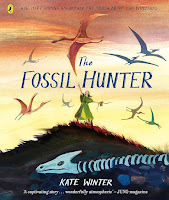
The KlausFlugge Prize is awarded to debut picture book illustrators. Winning an awardlike this is exactly the spotlight you need when you’re just starting inpicture books. A non-fiction book had never won before, but this year it did,with Kate Winter’s The Fossil Hunter. It’s the story of Mary Anning. Andit shows that a non-fiction book can have powerful visual story-telling.
I was lucky enough to have achat with Kate at an online event with the brilliant Just Imagine. She showed us the sketches of Mary that hadguided her making of the story. Mary often is holding a light, and I think Marylooking hard and shining a light into the past might be an important theme ofthe book.
 A Mary Anning sketch by Kate Winter
A Mary Anning sketch by Kate Winter Another sketch by Kate
Another sketch by Kate
To me, the illustrations in The Fossil Hunter are about capturing the lightand the moment and the feel – of what Mary Anning is experiencing.

There’s a looseness in the style of the pictures – they’re not toodetailed, not pinned down, gestural, slightly unresolved – so that yourimagination has space to fill in.
 Work-in-progress stages by Kate of an image from The Fossil Hunter
Work-in-progress stages by Kate of an image from The Fossil Hunter
If these pictures were more photographic, more realistic – we wouldn’thave that space to project onto them. The figure of Mary is often the onlywoman – alone, resolute, but also looking into a vivid vanished world.

Scattered through The Fossil Hunter are gatefold pages. The gatefold isan opening to a whole new world hidden beneath. Under the gatefold there’s ahidden layer, waiting to be discovered.

Sometimes the gatefold is a door into past worlds that are an explosionof colour, with Mary exploring.
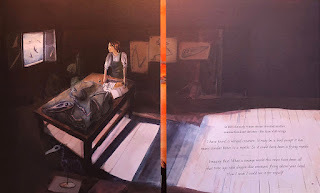

The gatefold is a way tophysically dip into the past, into a layer of parallel worlds, as Mary imaginesthe past, millions of years ago.
It’s also away to open a book of wonder, a cabinet of treasures.
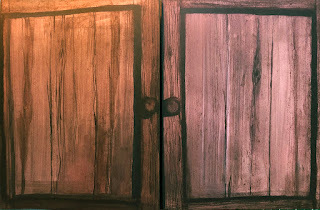

Sometimes fossils in shale can be like treasures hidden within the leavesof a black book, waiting for you to be the first creature to see them sincethey were buried in the mud, millions of years ago.
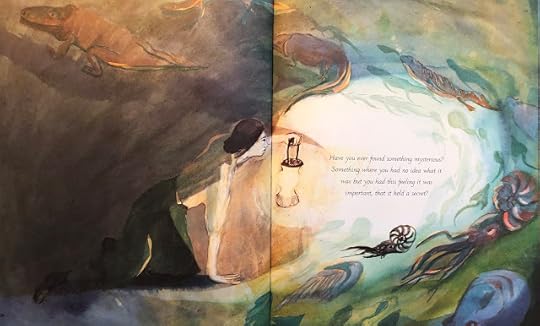
Here is Mary gazing into the unknown, again with her light to seefurther, to uncover secrets. The pictures are enabling us to feel Mary’swonder.
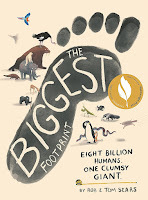
In Rob and Tom Sears’s book The Biggest Footprint, all of humanitygets smooshed into one giant human, 3 kmhigh.
They said about making it: “We started out with a weird thought experiment:what if, instead of 8 billion humans, there was justone, colossal mega human, smooshed together from all of our mass? How big wouldwe be? What would we be like, and what sort of mischief would we get up to?”
This book is about getting anidea of the scale of our impact on the planet. Numbers in the millions arereally hard for us humans to get our heads round, but this book tries topresent this visually, comparing numbers and sizes, always with something shownfor scale, so we can start to build the perspective to see what we’re up to asa species.

At the start there’s a huge crowd of 8 billion people – what are they queuing for? It turns out, it’s to go inthe smooshing machine.
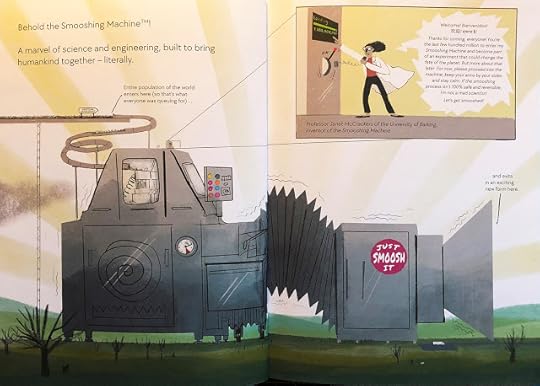
And what comes out of thesmooshing is a huge blue bemused mega-human.

The mega-human isn’t deliberately bad, but it’s clumsy and not reallyaware of how powerful it is.

For scale, all the wild tigers there are in the world (less than 4000) get smooshed into a 44 metretiger. It bounds out of the smooshing machine, a stripey flash, looking prettybig perched on the Taj Mahal…
 ...but then it fits easily on the thumbnail of themegahuman.
...but then it fits easily on the thumbnail of themegahuman. 
We get to compare the 3 kmheight of the megahuman with the smooshed mega giraffe (size: up to the ankle) Theunbelievable scale of what we’ve done to our planet in the last 100 years is shown by the changing sizes of the mega-animals.

Finally our mega-human meetsall-the-humans-who-have-ever-lived, and then a mega-creature who is All-Life-On-Earth,both of them increasingly enormous – but not as big as the monstrous ball thatis Everything-On-Earth-Made-By-Humans. And now I’m feeling dizzy with theperspective – the human-made world is now more massive than the living one.
 In this picture the small figure talking is All-The-Humans-Who-Have-Ever-Lived, the Mega-human is the teeny blue blob to the left of them.
In this picture the small figure talking is All-The-Humans-Who-Have-Ever-Lived, the Mega-human is the teeny blue blob to the left of them.The scale of our impact is incredible. The people of Earth are producingstuff (concrete, metal, tarmac etc) every week that is equal to theircollective bodyweight.


In these final spreads all the people of Earth have been de-smooshed – (thiscould have been a good gatefold!) How it makes us feel is an important factor –we’ve been included in the smooshing process, we’ve been taken on a tour of thescale of life on Earth and the scale of human impacts, we’ve been shown how wecould turn ourselves around, and we’ve been released from being smooshed to beindividuals who feel part of something with immense power – and what if thewhole of humanity got a Nobel Prize for turning the fate of the Earth around? Maybewe feel a bit of hope.
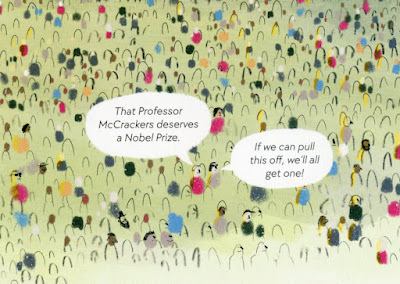
Tom and RobSears said:
“It is easy to feel hopeless. We tend to reason that the individualchanges we can make are tiny compared to the scale of the crisis. Well, thatmay be true! But the lesson of the mega human is that when we act together we dohave immense power, power to do both harm and good.
As 21stcentury individualists, it can be hard for us to accept the idea that being asmall part of something powerful ‘counts’ as real power. We’re fixated on howmuch individual control we can exert and we ask ourselves, “Why make a changewhen the world may crash and burn anyway? Or why vote when my one puny ballotpaper almost certainly won’t change the result?”
This isn’tthe way to think. The truth is you are part of something powerfulwhether you like it or not – whether you act or not. The question is whichlarger force you are going to be a part of.”
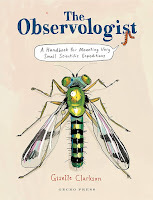
My final non-fiction book with heart is The Observologist, by Giselle Clarkson –it’s‘a Handbook for Mounting Very Small Scientific Expeditions’. This book finds thewonders in the everyday. The closer youlook, the more you see. Nothing is boring. Every creature is busy living &experiencing its own life, with its own hopes and fears, and it feels likesomething to be it.
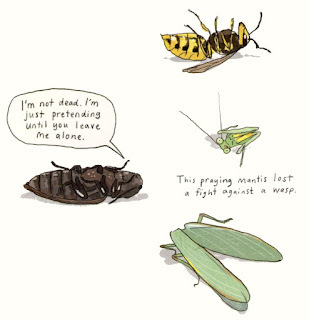
You can find tiny treasure. There’s usefulness in being bored. This bookis funny but also inspires curiosity and a fierce love of nature, and respectfor small creatures like the humble woodlouse. And that when you are observingand exploring, you are being a scientist. Clarkson doesn’t shy away from givingyou the proper science words for stuff – you are being respected as a scientistwho can deal with the real words.


Being a matchbox fan, Iparticularly liked this spread.
 'Just a fantastic creature'
'Just a fantastic creature'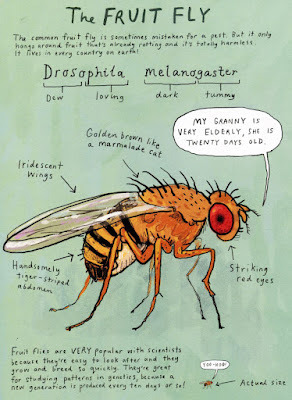 'Golden brown like a marmalade cat'
'Golden brown like a marmalade cat'
'
Keats, in his poem Lamias, complained that “Philosophy (AKA science, especiallyNewton) will clip an Angel’s wings,
Conquer all mysteries by rule and line,
Empty the haunted air, and gnomed mine –
Unweave a rainbow..”
Books likeThe Observologist show how wrong that is – that every tiny thing gets moreinteresting the closer you look, that the more you know about the world, themore extraordinary and strange and wonderful the universe and life on Earth become,and everything is interesting.
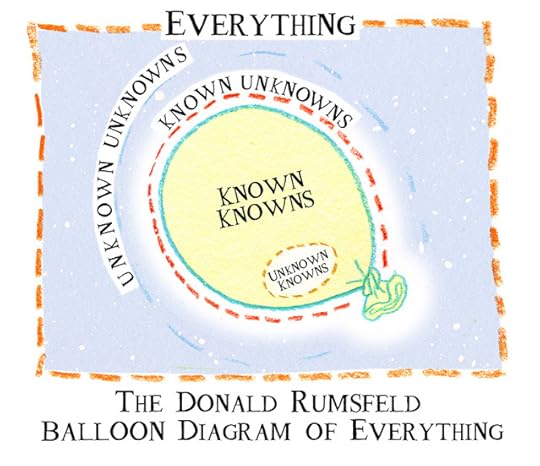 When I made this Donald Rumfeldt balloon diagram of everything, I discovered that as your balloon of KNOWNKNOWNS gets bigger, its skin – the membrane that is KNOWN UNKNOWNS gets biggertoo – so the more you know, the more you realise there is to know – and this isa good and exciting thing.
When I made this Donald Rumfeldt balloon diagram of everything, I discovered that as your balloon of KNOWNKNOWNS gets bigger, its skin – the membrane that is KNOWN UNKNOWNS gets biggertoo – so the more you know, the more you realise there is to know – and this isa good and exciting thing.
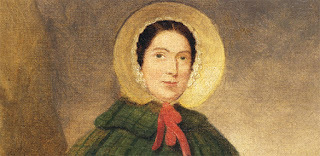 Mary Anning had no idea of Darwin’s big idea, she lived too early. Inher time, creation was all made by God, and animals were all separate creations– humans most separate of all.
Mary Anning had no idea of Darwin’s big idea, she lived too early. Inher time, creation was all made by God, and animals were all separate creations– humans most separate of all.
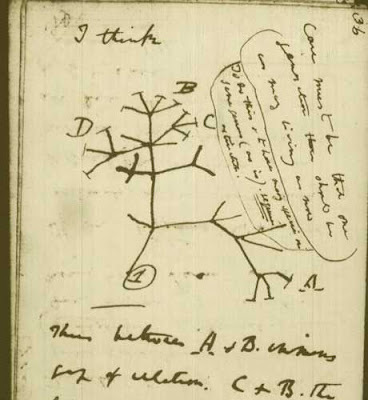
Darwin’s great idea, sketched in a notebook – was that everything isrelated, it is all linked together in a tree of life: we are woven together andrelated to everything and everyone else who has ever lived on earth, frombacteria to sponges to sharks to tigers to humans. The fact that we’re alive onthis improbable, beautiful, vanishingly rare, precious pale blue dot of aplanet is a miracle, an impossible wonder.
Mini's latest book is The Greatest Show on Earth, published by Puffin.
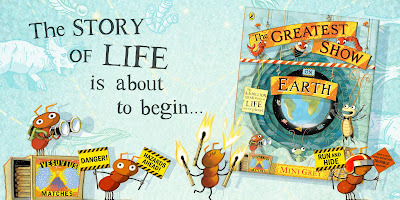
November 3, 2024
HAVE BAD IDEAS! Moira Butterfield
It’s Yoda time on the blog this week. Read on for a simple but INCREDIBLY IMPORTANT truth about being a creative. And don’t just listen to me. There are some links at the bottom to press home the point further.
That title’s not a negative, by the way. It’s a positive, and by embracing this message you will become a much stronger creator.
Have bad ideas to get better is the opposite of what many people imagine is the creative life.
TRUTH: Creators do not come up with perfect work straight off the bat. They might pretend they do. They might quite like you to think they’re unusual geniuses with some kind of hotline to the muses. But the truth is, they will have made – and continue to make – bad work in order to get the best. They will have taken ‘wrong ‘pathways. The chances are they will have thrown stuff in the bin after spending ages on it.
The view that good creators only make perfect things is not that surprising - because you may well have been encouraged to think that in school. There your writing/painting/creative project is judged good or not good. Right or not right. I think it’s why so many people give up on art early on and say ‘oh I can’t do that’. They didn’t do it ‘right’ first time and that was that.
But if you continue with that view you will struggle – I will go as far as to say you won’t make it – as a creator in any field.
Wrong is the fertiliser of right. It’s the path you take to eliminate things, learn things and ultimately find the best way.
Let me tell you something about myself. I’ve had many books published and I have many ideas in drawers and folders that aren’t yet right and perhaps might never ‘work’ as they stand. Through my agent I’ve done deals for many books, but there have also been plenty of ideas she has said no to, and plenty that publishers have said no to. There are also ideas I haven’t shown anyone because they didn’t gel.
It all happens regularly. I’ve failed lots and lots. But, though it doesn’t look as if I’ve got anywhere with something, it doesn’t mean it won’t come back later and evolve, or feed into a different project. Maybe it will turn out to be ‘the wrong bit of the path I went down so I could find the right bit’.
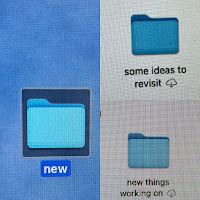 Ideas hiding in folders on my computer, some
Ideas hiding in folders on my computer, some of them bad!
Yes, of course bad ideas can feel disappointing for various reasons – ‘I thought that was OK’, ‘I spent a lot of time on that’. it’s hard to bounce back sometimes, when work you’ve spent time on doesn’t make it through. But it has happened to me many, many times so I know that it’s actually a normal and recurring thing for a creator working seriously in their craft. Gotta dust down and go again.
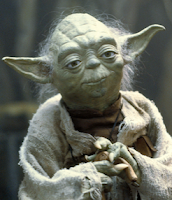
As Yoda says – The Greatest Teacher, failure is.
Now this only works if you’re prepared to learn from your setbacks. You need to be up for changing paths and continuing your journey from a different angle. If you meet someone who says ‘everyone else is wrong’,‘it’s all because gatekeepers are biased against me’, ‘I won’t change my idea. It’s great’. – then you’ve met somebody who won’t succeed because they won’t allow themselves to learn and try new angles.
It's the same for mega-successful creators. If they decide they are geniuses who can’t be gainsaid and don’t need to alter anything then it quickly becomes obvious in their bloated unedited work. They forget they are on a learning journey, like everyone else, and get bogged down in the quicksand of self-delusion.
For more on this subject (and other thoughts on being creative) I’d like to recommend US picture book creator Andy J. Pizza’s podcast – Creative Pep Talk. He emphasises this blog’s point over and over. He calls it Booby Traps mean Treasure. You’re on a journey and the booby traps you meet are proof that you’re still on it and still have a chance to succeed! Andy’s episode 349 lists 10 rules of creative practice, and he suggests it’s a good place to start listening and get a flavour of the podcast. He's super-enthusiastic and encouraging.
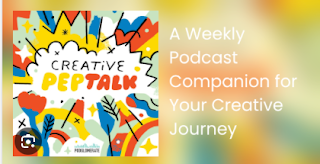
Through that podcast I heard about Seth Godin – who says in his TED talk ‘if you want more good ideas have bad ideas’.
He’s not wrong!
https://ideas.ted.com/heres-why-you-need-to-have-more-bad-ideas/
Moira Butterfield is an internationally-published children’s author. This year her publications include The Secret Life of Bugs (Happy Yak/Quarto) Look What I Found By the River (Nosy Crow/National Trust), Welcome To Our Playground (Nosy Crow) and Does a Bear Wash its Hair? (Bloomsbury).
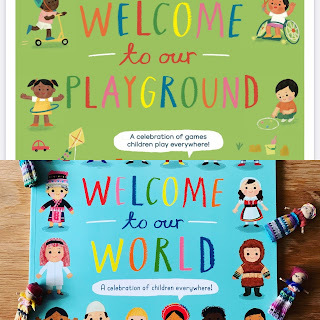
Instagram/threads @moirabutterfieldauthor
October 21, 2024
Getting in to a Flap! Garry Parsons lifts the lid on picture books with flaps and reveals some hidden surprises
The inclusion of flaps in picture books can undoubtably add an exciting extra level of interest for the reader. After all, who can refuse the temptation of lifting a flap in a picture book? Not me!
The flap is not only about encouraging reader interaction, but it can also add another level to the storyline by revealing text as well as hidden illustrations and therefore, moving the story forward through the reveal.
The flap acts as a mini page turn and has many options for the writer and illustrator to consider as a way of pushing the story forward. For example, when opened flat, the flap can alter the image it covers in a way that changes the action and in a very simple way, suggest the beginnings of movement, encouraging the reader to flick the flap back and forth quickly to animate the changes.
 Exploring using flaps to change expressions -Work in progress. Garry Parsons
Exploring using flaps to change expressions -Work in progress. Garry Parsons
Making the flaps work brings its own challenges for the illustrator and designer and poses some interesting questions about the purpose the flap is there to achieve? Are they necessary for enhancing or pushing the storyline forward, does the reveal change with the text or is the inclusion of flaps simply there as a sales lure from the publisher?
Technically, flaps can appear almost anywhere on the page so long as they are clear of the gutter (the centre fold) and can be relatively any size or shape within the book’s dimensions. The largest flap is the gatefold, a page that has been made double the size and folded back on itself on one side which when opened extends the spread out to the side, top or below. This can be single or double to extend the spread from either side.
The possibilities are many but what is certain is that the reveal needs to be satisfying for the reader. As a participant in the story, we want the flaps to be irresistible but more importantly, we want the reward of being delighted by revealing the secret of what’s hiding underneath.
Having completed a few picture books with flaps myself and currently working on a another, I've had the opportunity to explore flaps in picture books again recently and come up with a few enticing titles to share, starting with books with small flaps and ending with, well…all will be revealed!
Nuddy Ned's Christmas. Kes Grey.
Kes Gray's Nuddy Ned's Christmas uses small irregular shaped flaps to reveal and conceal at the same time. The story follows a young boy who, like many young children, enjoys running around the house naked, except here, oblivious to his lack of clothing, Ned leaves the warm confines of home to explore the town in search of Santa, but completely starkers. However, each flap reveals something that also conceals Ned's modesty, turning the joke back on the reader.


Somehow, Ned's streak through town convinces Santa that being in the 'altogether' is something he might want to try. Our last flap to open is covering Santa's seemingly bare bottom. Lift the flap if you dare!

Meerkat Mail. Emily Gravett.
Leaving in search of some respite from a chaotic family life, Sunny leaves the desert but keeps in touch with the relatives via postcards and letters. In Meerkat Mail, Emily Gravett uses flaps as Sunny's communication home.
Not only do we get to read Sunny's correspondence, but the reveal also extends the action through the illustration underneath. On this spread, Sunny returns home to the closeness of the family that he's been missing.
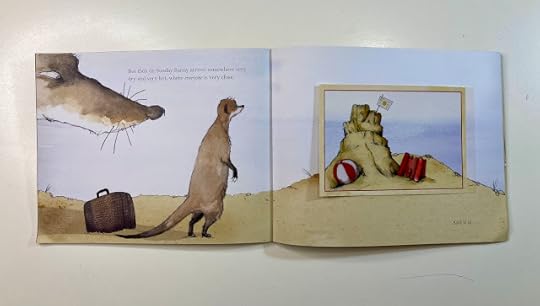

Animalalphabet by Julia Donaldson and illustrated by Sharon King-Chai.
Animalalphabet uses a clever combination of peep-hole pages and fold-out flaps to reveal and then hide animals.




Stuck in the Mud. Jane Clarke, illustrated by Garry Parsons.
The tension for the farm animals in Jane Clarke's Stuck in the Mud build's and builds over each page turn with the inclusion of a new animal joining the throng as the story progresses. More and more animals arrive to rescue the helpless chick who is stranded in the mud. The single gatefold at the end reveals the story's punchline, that the not-so helpless little chick has been deceiving everyone all along, including the reader.
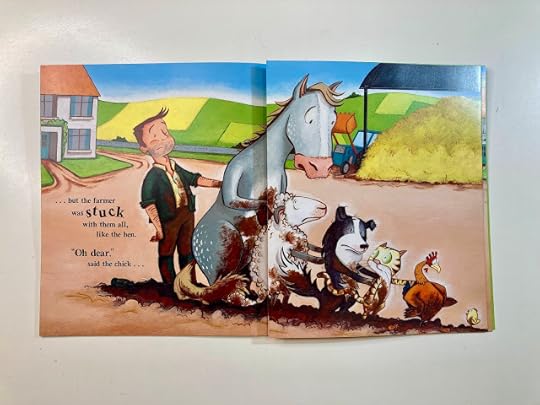

Jim, A Cautionary Tale by Hilaire Belloc. llustrated by Mini Grey
In Jim, A Cautionary Tale by Hilaire Belloc and illustrated by Mini Grey, the story includes an array of flaps, folded reveals and clever pop-up elements but begins with a potted outline of Jim's life.
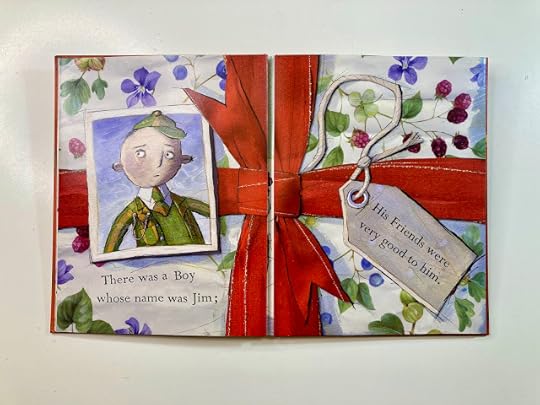
A double gatefold extends left and right to reveal a giant spread of delicious indulgence.

Incorporated into the double gatefold are extra flaps which reveal the next lines of the text
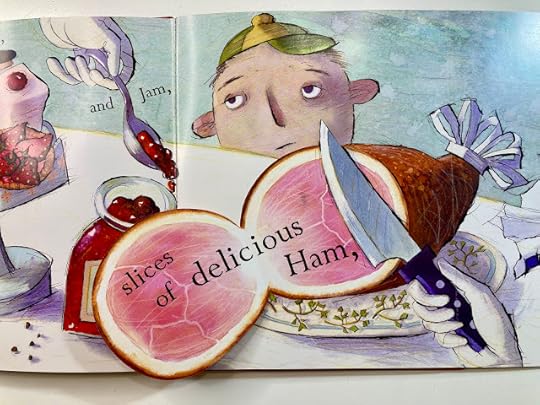
with this one revealing the gooey pink inside the chocolate!

Flora and the Peacocks by Molly Idle
Flora and the Peacocks by Molly Idle is a wordless picture book, adorned with flaps which increase in size and frequency.
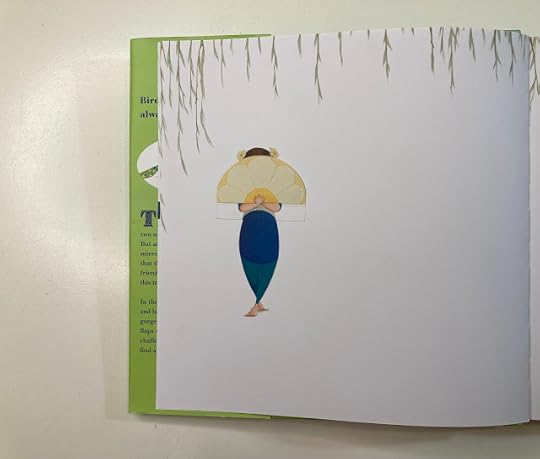
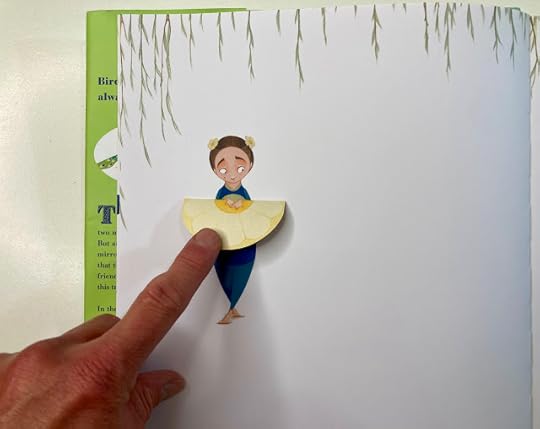
Flora dances with a pair of peacocks who echo the movements of her fan. The reader is invited to lift the flaps of both Flora's fan and the flaps of the peacock's tails, encouraging a unique choreography.
In the story, Flora (and the reader) dance with the birds until the fan gets broken. Disheartened, poor Flora is left annoyed and upset, but the peacocks have a a magical way of cheering her up.

More akin to a pop-up element than a flap and increasing the book size twice over, the reveal is too astonishing not to include.

So, Hooray for the delights of flaps!
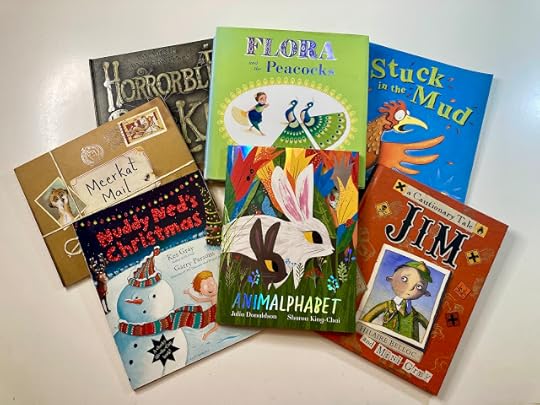
For more about flaps from an earlier post, scroll or search the Blog Den archive or find it here...Hide and reveal - The irresistible joy of lift-the-flap books - Garry Parsons
***
Garry Parsons is an illustrator of many popular books for children including the recent bestselling picture book The Dinosaur That Pooped Halloween by Tom Fletcher and Dougie Poynter. WARNING - This book contains SPOOKY flaps.
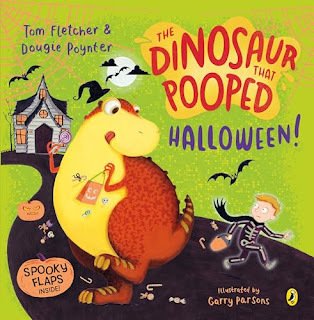
Visit www.garryparsons.co.uk and Follow Garry on instagram @icandrawdinos
***
October 6, 2024
CAN YOU WRITE A PICTURE BOOK WITHOUT WORDS? by Clare Helen Welsh
Back in June, I wrote a blog post that asked if it was possible to READ a book without words. Now, here’s the sequel you’ve all been waiting for!
Can you WRITE a picture book without words?
Absolutely! You can!
Can a story be told entirely through images? Can a picture book exist without words? Even if you’re the author only and not an illustrator?
YES!
Wordless picture books offer a unique and powerful way to tell stories. But for aspiring picture book writers, the prospect of creating a wordless story may seem daunting.
In June 2024, my (almost!) wordless picture book, Moon Bear, published with Frances Lincoln. It’s about a girl called Ettie who is afraid of the dark. She meets a magical moon bear who is afraid of the light. I was not the illustrator on the project. I was the author only - my co-collaborator was the awesome Carolina T. Godina. Creating this book was an exciting and creative challenge, and because of that, I'd like to suggest to other writers that it's worth exploring.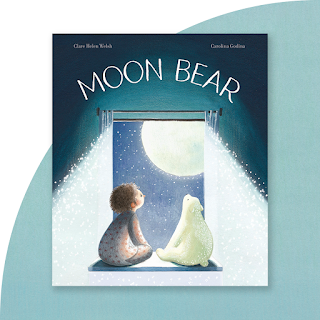
What I learned when writing a wordless picture book, is that all the usual picture book ingredients are needed – a strong hook, an interesting concept, compelling characters and a satisfying plot.
In this post, I’ll explore how to approach writing a wordless picture book as a writer only and offer some key tips to guide you in the process.
Tips for Creating a Wordless Picture Book:
1. Plan the narrative arc
A wordless picture book still needs a clear narrative structure. There needs to be just enough threads that the reader can interpret and co-create the story, and re-create it on subsequent reads, without there being so much going on that it’s impossible to pin down and follow one controlling idea.
To create a clear beginning, middle, try writing a mini synopsis, then write or sketch a storyboard of key scenes like a film director would.
Here’s the short synopsis I wrote for Moon Bear.

2. Let the illustrations convey emotion
In a wordless book, emotions need to be conveyed through facial expressions, body language, and colour. You'll need to dramatise the storytelling - show it, not tell it. Consider how you will emphasise the emotional highs and lows of the story in pictures alone. For example, maybe you’ll use darker tones and close-up compositions for scenes of sadness or fear, in contrast to bright and open happier and energetic moments. It might help to imagine an illustrator you'd love to work with. I imagined Briony May Smith when working on Moon Bear.


3. Create tension and resolve conflict
Every good story needs conflict and resolution. Whether your story is about a lost animal, an exciting adventure or self-discovery, there should be a sense of tension that propels the story forward.
The challenge in a wordless book is making sure that this tension is visible. Of course, much of this will become evident when an illustrator comes on board, but consider what you can do to strengthen tension and resolution in your written submission. When you present your wordless picture book, it will look like a collection of detailed illustration notes. Can you see how I helped my agent and editor visualise tension through the character's action?

4. Use repetition and pattern
Repetition can be a powerful tool in a wordless picture book. By repeating certain visual elements, you can create rhythm and shape that helps the reader feel grounded in the story. It also encourages them to anticipate what comes next, adding depth and engagement to the reading experience.
For example, in Moon Bear, Ettie’s bedtime scenes are repeated at the start and at the end. The first time she is afraid – she doesn’t want Mummy to leave. The second time, when she is no longer scared of the dark, she pushes Mummy out the door!
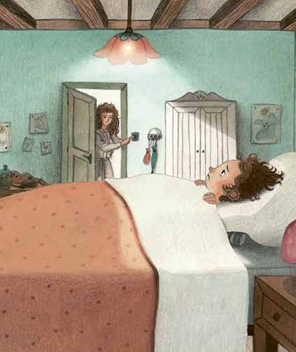

5. Play with page turns
In a wordless picture book, the moment when the reader turns the page can be used to create suspense or surprise. Consider how you can use page turns to heighten, reveal, surprise or engage the reader at important moments.
Here's a page near the end of Moon Bear that I think keeps the reader engaged and encourages them to predict what will happen next.

6. Use visual details to deepen the story
Wordless picture books allow for rich layers of detail. Include scope for visual details that hint at backstory, character development, or future events.
For example, have you spotted the cat in the opening spread of Moon Bear? And the clock that shows Ettie’s bedtime? It shows 7pm when Ettie is stalling, and 3:30pm when she is excited to meet Moon Bear again. These details invite readers to engage more deeply with the book and make new discoveries with each reading.
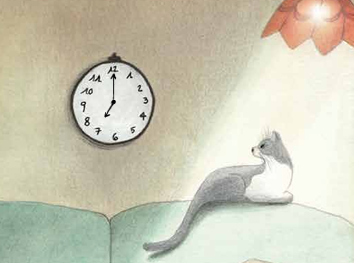

7. Share your story with critique partners
One of the best ways to ensure that your wordless story works is to share it with critique partners. See if they are able to follow the plot. Do they understand the themes? Is anything unclear? Their feedback will be invaluable in refining your narrative.

Wordless picture books are a challenge, a joy and a wonder. They can help children feel happy and confident to read at their own pace, making them an active participant in the storytelling.
Why not challenge yourself to write one? It’s a great lesson in showing, not telling. You’ll learn about pacing and what’s realistic in terms of page layouts and illustrations and the art of a telling a focused and satisfying tale. You can always try a version with words at a later date, and it might make for an interesting starting point.
There’s no right or wrong way to read a wordless story, and no right or wrong way to write one either. But hopefully the tips above will help.
Can you write a wordless picture book?
Absolutely! You can!
Clare Helen Welsh is a children's writer from Devon. She writes fiction and non-fiction picture book texts - sometimes funny, sometimes lyrical and everything in between! Her latest picture book is called 'Moon Bear,' illustrated by Carolina T. Godina and published by Frances Lincoln. You can find out more about her at her website www.clarehelenwelsh.com or on Twitter @ClareHelenWelsh . Clare is represented by Alice Williams at Alice Williams Literary and is the founder of #BooksThatHelp.
September 8, 2024
Mindful Picture Book Writing by Chitra Soundar
As a writer and with someone who learnt meditation as a child and had forgotten its benefits until recently, re-visiting the basic concepts of mindfulness has been very useful. Especially as a picture book writer – paying attention to the story and words, using a word with intent and not judging our own work critically until it is ready to be judged are all mindful things we do and we can do in our writing practice.
So what does it mean to be a mindful picture book writer?
a) The first step is always showing up – setting aside a time for the writing and actually showing up. Regardless of the incessant chaos of our lives, we show up to write.
b) The second step – especially useful for writers – is to be mindful of your own self and the surroundings. Most mindful practices start with mindful breathing. You quietly say In and Out as you breathe in and out deeply. Then observe the surroundings and try and write the five senses about the surroundings – from your noisy keyboard making clickety-clack noises to the smells from the kitchen or how cold or warm you are. What can you see – colourful posters or a bland white wall? Acknowledge all of those mindful observations.
You must wonder how this can help. It helps because the more you do this, the better you get at observing spaces around you and consciously remembering the five senses about those spaces. What can be more useful to writers than training your brain to consciously record details of life to use later in the writing?
c) The third step – is to imagine your characters mindfully in their space. Deliberately allow them to wander in their space. Even if you’re not an illustrator, you might have an idea where your character is at any point in time in the story – consciously wander and add sensory details that you have been accumulating by doing step (b).
It is easy to get distracted – your character might go off to different places, go with the flow. Perhaps the story might be led in a different direction. Or you might get distracted about what to cook for dinner or which book you’re going to read next. When that happens, bring your character back to where they were before your mind wandered off and start again.
Step (b) and (c) are really hard to do when you actually begin doing them. Start with 1-minute exercises and build up your stamina to do longer durations.
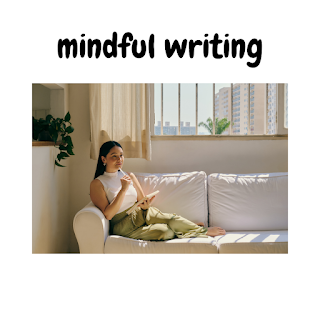
d) Now when you write your story or rewrite – channel all those experiences your character had with all their senses into the words. Because you travelled with your character into those spaces and felt what they felt, smelt what they smelt and tasted, watched and heard everything, perhaps your verbs will be active, your nouns specific and the emotion strong.
Picture books especially with a smaller word count are acts of intention.You have a specific shape to the story. You have to choose precise words that invoke visuals and emotions in the editor / illustrator’s mind. And when you pay attention and do it with intention, you will slowly start seeing much stronger text on the page. But it is going to take time. Entering this space without judgement is the third aspect of mindfulness.
Writing is often like the critic and doubter in us trying to wrestle control from our creative energy. As most writing books will say, and I can vouch for it as a writer myself and you can too, there is a place and time for everything. So when you’re writing mindfully, park the critic and doubter outside. Pay attention to the task, do it with intention and without judgement.
Then when you have got your draft on the page, bring the critic in and again pay attention, edit with intention and without judgement. Just because you can’t wrestle a story into shape doesn’t mean you’re a bad writer, it means this particular story needs more time – thinking time, imagining time, resting time and maybe rewriting time. If you get judgemental about it, it will cloud your intention of making it better and try to reject the writing.
So, the critic must be mindful as well – they are critiquing the words, not you the person. They are doing it with intention – this morning they are only critique structure, maybe a few days later, the critic can return to review just the words. Put intention into your edits.
And you will end up repeating this process of mindful writing and mindful editing over and over again for the same story. But as you keep practicing the mindful way, perhaps you might not need that many rounds.
I first combined meditation and writing in 2010 when I went on writing retreat run by Natalie Goldberg because her book Writing Down the Bones had brought me back from “not writing at all” to writing. It had a profound impact on me and still is my go-to cure for I can't write conditions.
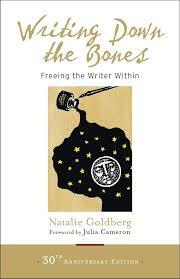
Nestled in the mountains of New Mexico, inside a Buddhist monastery, we did silent practice, sitting for meditation and writing with intention. It may not be connected, but in 2012, three of my picture books got accepted.
I don’t always remember to be mindful, for sure. Especially as a children’s author, I’m doing events, I’m writing and working on multiple things and I have 100 different new ideas I want to write. But when my mind is busy and I feel like I’m hopping from one lily-pad of obligation to another, I find a quiet day just to sit with myself and my notebook.
Also, when we were all confined inside when the plague hit us again, I started Write30. A bunch of us gather together every Friday (most Fridays), virtually, for 30 minutes and write to a prompt. The writers who join have already done the first step – finding the time to write. Then we pay attention to the prompt and we write. We write with intention on the prompt – but still engaging our individual creativities. I’m sure that even with a single prompt, all of us would have come up with different stories or passages or poems. Then we are non-judgemental. We talk about the experience of that writing, but we don’t read anything aloud, we don’t mock ourselves, we don’t criticise ourselves if the prompt didn’t work. We just reflect. If you want to join our #write30 meetings, email me and I will add you to the invites.
If you want to delve deeper into mindful writing, then I’d recommend another book that will guide you step by step through the process and also provide exercises. Check it out.
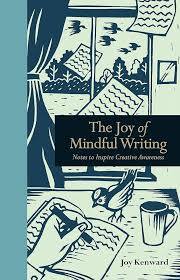
I realise this mindful practice of writing is not just for picture book writers. But personally, I feel picture book writers have a bigger need to be purposeful and intentional with their words and pictures. They need to pick their words with intention to tell the story and what can be more mindful than that?
If this resonates with you or if you try mindful writing, then do share your thoughts with us in the comments. If you want to join the weekly #Write30 session, do message Chitra directly.
 Chitra Soundar is an internationally published, award-winning author of children’s books and an oral storyteller. Chitra regularly visits schools, libraries and presents at national and international literary festivals. She often runs writers' surgeries, courses and teaches writing to writers, teachers and children. She is also the creator of The Colourful Bookshelf, a curated place for books for children by British authors and illustrators and a co-founder of SAIL Fest. Her latest picture book is Garland Of Lights (A Diwali Story), illustrated by Amberin Huq. Find out more at http://www.chitrasoundar.com/ and follow her on X (ex-twitter) here and Instagram here.
Chitra Soundar is an internationally published, award-winning author of children’s books and an oral storyteller. Chitra regularly visits schools, libraries and presents at national and international literary festivals. She often runs writers' surgeries, courses and teaches writing to writers, teachers and children. She is also the creator of The Colourful Bookshelf, a curated place for books for children by British authors and illustrators and a co-founder of SAIL Fest. Her latest picture book is Garland Of Lights (A Diwali Story), illustrated by Amberin Huq. Find out more at http://www.chitrasoundar.com/ and follow her on X (ex-twitter) here and Instagram here.
August 25, 2024
Colours as a Picture Book Theme, by Pippa Goodhart
Colours!
Colours are one of those concepts that young children learn early, along with numbers and opposites and shapes. We adults have a natural instinct to tell and reinforce colour labels in order to teach children these things. I’ve just been sharing books with my one-year-old granddaughter, and observed myself asking her, ‘Where is the blue elephant? Can you see a pink bird?’ even when the text of that book makes no mention of colour.
For that teaching reason, colours as a theme are a natural match for a very young audience. But of course they are also visual, and perfect for picture book treatment.
Picture books focussing on colour play with colours in different ways. There are those simply naming and showing coloured objects. And there are those which use colour within a story context. I’m going to show two of my favourite examples of colour-based stories, but first of all I want to show off my own new board book, Colours of Things!
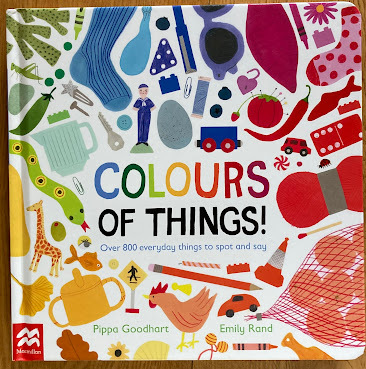
My text is a simple rhyming one –
‘Red cherries, a red door, red jam and a parrot.
Orange bunting and T-shirt, marigolds and a carrot.
Yellow banana and crayons, and bright yellow hair.
Green grass, a green dress, green grapes and a pear.’ … And so on through blue,
purple, pink, brown, silver and gold, to …
‘White mittens, a kitten, a snowman, a cup …
And all sorts of things that just mix colours up!’
But its Emily Rand’s gloriously rich array of coloured objects in her illustrations which offer so many everyday examples and so much to notice and talk about.
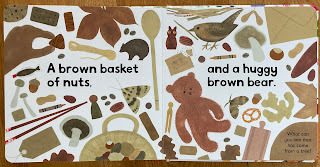
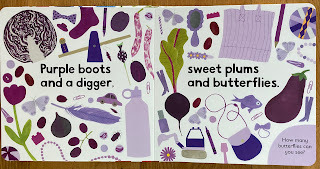
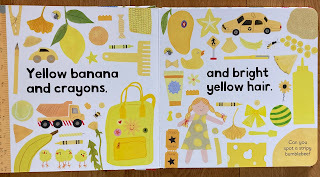

‘Wow!’ Said The Owl by Tim Hopgood is a beautiful board book story in which a curious little owl stays awake during the day, and sees colours she hasn’t experienced at night.
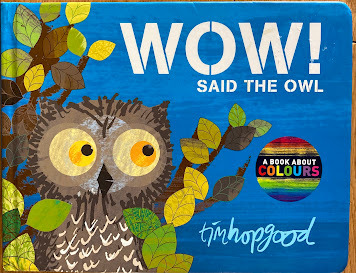
A pink dawn sky, a yellow sun, blue sky, green leaves, red butterflies, grey clouds and rain, all seen from her tree, and all eliciting a ‘Wow!’ reaction.
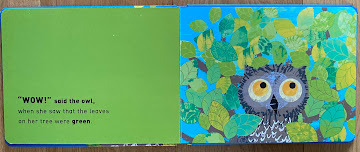
Then, best of all, …
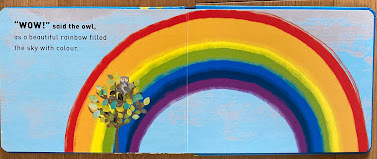
And the night has ‘Wow!’ wonders too. Such a lovely book.
For slightly older readers, and in paperback rather than board book format, is The Colour Monster by Anna Llenas. With wonderful, almost 3D seeming, collage and scribbly oil crayon artwork depicting characterful characters with energy and humour, this is a story that equates colours with moods.

Colour Monster is very confused, and doesn’t know why, so the capable girl narrator of this story takes him in hand and sorts him out.
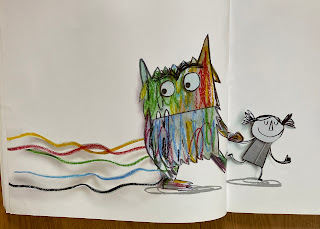
He needs to recognise and separate his colour moods. Happiness ‘shines yellow like the sun and twinkles like the stars.’ Sadness is ‘gentle like a blue rainy day’. And so on.
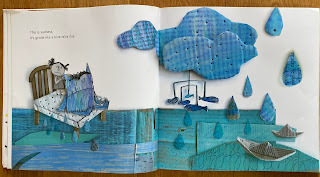
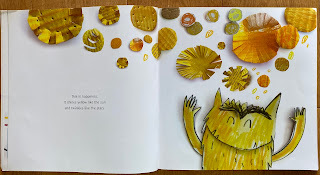
Look at fear …
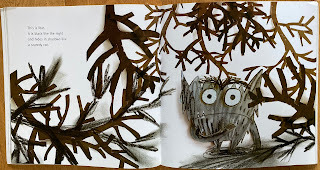
All get firmly sorted. But then another colour appears that the fierce know-it-all narrator girl is confused by …
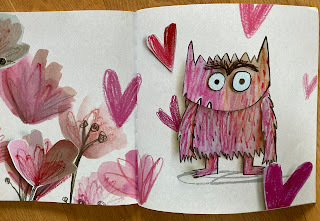
Profound, beautiful and funny. A brilliant book. Perfect as a starting point for children to make their own mood colour collages.
How else has colour been used in picture books? Do, please, add and share examples in the Comments below.




